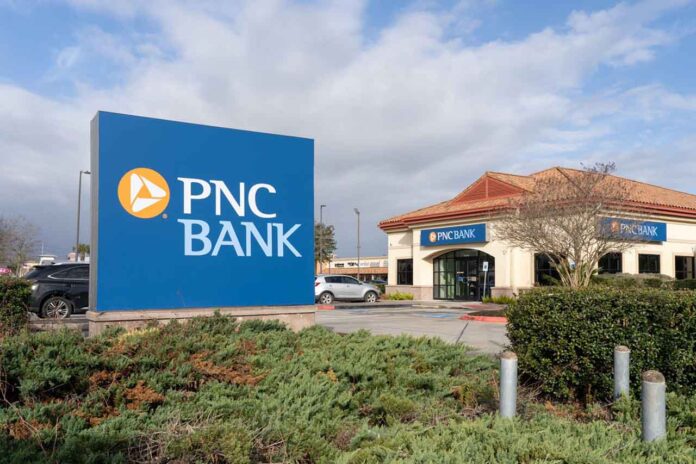PNC Bank closures 2023: Imagine walking down to your local PNC bank and finding the doors permanently closed. For some, this has become a reality as PNC, the bank that has woven itself into the financial journey of many American lives, announces a spate of closures across various states.
But what’s really happening behind the scenes? Is it a sign of financial turmoil or merely a strategic move adapting to modern banking trends?
In this article, we will take a closer look at recent developments at PNC Banks to uncover the recent for the recent massive branch closures. If you are one of PNC’s 14 million customers and looking to understand what’s really happening with PNC Bank closures in 2023, just keep reading!
Table of Contents
A Quick Overview of PNC Bank
PNC, the sixth-largest bank in the U.S. by total assets, harboring a hefty $552 billion and housing a massive customer base of around 14 million, has notably been a stable pillar in the American banking landscape since its foundation in 1845.
Headquartered in Pittsburgh, Pennsylvania, the bank has not only witnessed the country’s financial evolution but has actively partaken in it. PNC has survived and thrived through various economic conditions over the centuries.
From local banking services to providing comprehensive financial services nationwide, PNC has steadily crafted its legacy. And this makes the recent announcement of closing down 203 branches in 2023 a thing if great concern for everyone.
PNC Bank Closures: PNC to Close Down 203 Branches in 2023
In an official bulletin released on April 21 by the Office of the Comptroller of Currency (OCC), PNC unveiled its plan to shut down 30 branches scattered across seven states: Alabama, Ohio, Florida, Texas, Illinois, Virginia, and Maryland.
But this is just a portion of the iceberg. Pittsburgh Business Times estimates indicate that this decision forms a part of a larger scheme, spiraling the total closures in 2023 to approximately 203.
These closures, however, don’t spell immediate changes for PNC customers. Bank protocols necessitate a 90-day advanced notice before any branch is sealed off. Consequently, branches disclosed in the April announcement did not officially close their doors until July 21, while others announced earlier in March ceased operations in June.
But why is a banking titan that has stood its ground for nearly two centuries closing so many branches at once?
Why Is PNC Bank Closing So Many Branches?

If you are presently wondering what could have informed the recent PNC Bank closures, then you are not alone. Upon hearing the news that the notable bank will be shuttering multiple branches this year, questions have arisen in the minds of their customers and enthusiasts.
Well, PNC’s decision to shutter multiple branches isn’t impromptu. It’s a calculated move that aligns with the gradual shift in banking trends. If you have noticed, customer preference has continued to tilt towards mobile and digital banking over the past decade. That has affected the operations of many banks, causing them to make huge decisions, including shutting down many physical branches.
Since 2012, PNC has been steadily closing branches that no longer see the foot traffic to justify their operational costs. It’s crucial to note here that while branches are closing, the customer base is not dwindling – rather, it’s morphing, choosing online banking with PNC over in-person transactions.
Evidently, PNC is not merely surviving amidst these changes but is, in fact, thriving. A flashback to 2012 reveals a net income of $3 billion and total deposits of $213 billion, which, when compared to the net income of $6.1 billion and total deposits of $436 billion in 2022, paints a picture of growth and adaptation rather than decline.
You may also like:
PNC Bank Closures: Should Customers Be Concerned?
In the ever-volatile world of finance, where the recent failures of banks like Silicon Valley Bank, Signature Bank, and Silvergate Bank are still fresh in memory, PNC’s branch closures might trigger alarm bells for some.
However, a deep dive into the facts might bring solace to many worried souls. To begin with, these branch closures, as aforementioned, are not indicators of financial distress. They represent a strategic shift toward new banking paradigms.
This is underlined by PNC’s consistent acknowledgment of its customers’ preference for online banking. The bank isn’t losing clients; it’s adapting to their changing needs.
Apart from that, PNC’s financial health, as showcased by its recent Q1 2023 earnings, is impressive. The bank recorded a net income of $1.7 billion, marking a 9% quarterly growth. The surge in deposits, amounting to $1.3 billion, even amidst growing skepticism about the banking system, indicates that many still trust PNC with their financial resources.
Is PNC Facing Financial Challenges?
In understanding the financial stability of a bank, a significant metric to consider is the Tier 1 common capital ratio. This percentage highlights a bank’s ability to endure financial stress, with a higher ratio suggesting robustness. The industry benchmark sits at 7%, but PNC proudly boasts a substantially higher figure: approximately 9.2% as of March’s end. This indicates that even in a hypothetical financial crisis scenario, PNC seems capable of weathering the storm.
But there’s more. PNC’s long-term debt, as of June 30, 2023, stood at $65.384B, showing a substantial 81.7% year-over-year increase. Compare this to the debt in 2022, which was $58.713B, a 90.73% surge from 2021. While these figures might sound concerning at a superficial glance, it’s crucial to view them in context with the bank’s overall assets and growth strategy.
So, is PNC facing financial challenges? We don’t think that is the case. Considering its recent figures and report, it seems the bank is improving its finance.
What States Are Most Affected by PNC Bank Closures?
Branch closures always have a ripple effect, impacting local economies, jobs, and accessibility to banking services. In PNC’s case, the states bearing the brunt of these closures include Virginia, Texas, New Jersey, and Alabama. Moreover, North Carolina is witnessing the shuttering of three crucial branches in Gastonia, Wilmington, and Candler.
However, we should all know that while closures might inconvenience some customers in the short run, the strategic pivot toward digital banking ensures a broader reach and convenience in the long term.
Final Note
The headlines of “PNC Bank closures” have undoubtedly stirred discussions and speculations. But, when the dust settles and the facts are laid bare, the narrative becomes less about financial instability and more about strategic transition.
In the age of digital transformation, where mobile banking is not just an option but a preference, banks like PNC are making calculated moves to stay relevant and efficient. So, if you are one of the customers of PNC Bank, this is not the time to panic. It doesn’t mean the end of PNC bank, and your money is still safe with them.
FAQs
Is PNC Going Out of Business?
No, PNC is not going out of business. While the bank is closing several branches across various states, this move is not indicative of the bank shutting down entirely. The branch closures are primarily a response to changing banking trends, with more customers opting for digital and mobile banking services.
Which PNC Banks are Closing in North Carolina?
In North Carolina, PNC has decided to close branches in several locations, including Gastonia, Wilmington, and Candler, according to filings with the Office of the Comptroller of the Currency.
What Country Owns PNC Bank?
PNC Bank is owned by The PNC Financial Services Group, Inc., which is an American bank holding company. The headquarters is located in Pittsburgh, Pennsylvania, USA. Founded in 1845, PNC Bank has become one of the prominent banks in the United States and operates as a subsidiary of its holding company, maintaining its roots in American ownership.
Is PNC in Debt?
Yes, like many large organizations, PNC does carry debt. As of the quarter ending June 30, 2023, PNC Financial Services reported a long-term debt of $65.384 billion, which represents an 81.7% increase year-over-year.
In 2022, the long-term debt was $58.713 billion, indicating a 90.73% increase from 2021. However, you need to understand that having debt is not uncommon in the banking industry, and it’s essential to consider this figure in the broader context of PNC’s assets, equity, and overall financial performance.
















